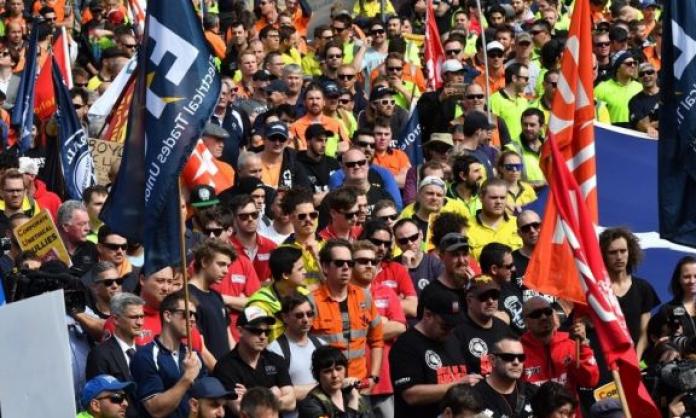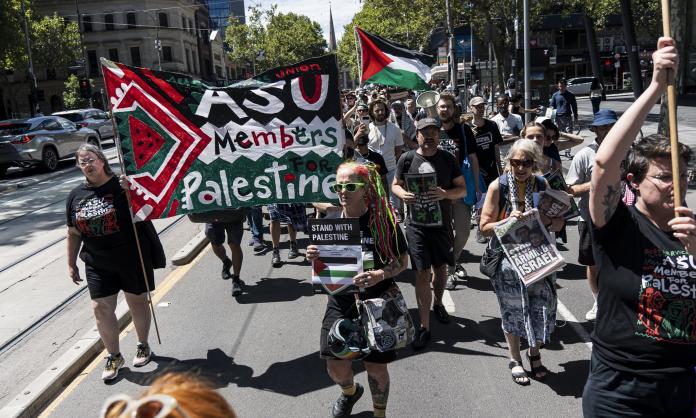Penalty rates slashed. A renewed attack on the construction unions. Long-established conditions trashed at key industrial sites. And now, courtesy of Fair Work’s decision to scrap the enterprise agreement at Murdoch University, a renewed onslaught on white collar workers in government-owned institutions.
This is a vicious turn in the class struggle. It’s time to take stock of where the class struggle is at and how our side is faring.
The end of the post-WorkChoices lull
Most of the period since 2007, industrial struggle in Australia has reflected an uneasy truce. The 2007 electoral landslide that tipped the Liberals out of government and cost John Howard his seat resulted in the demise of the Liberals’ WorkChoices assault on workers’ living standards and union rights.
The Rudd/Gillard/Rudd government left the framework of WorkChoices in place, including tight restrictions on industrial action. However, some of the most punitive anti-union aspects were scaled back – for instance, loosening very strict limits on what could be bargained over, and (eventually) easing union right of entry provisions.
By 2012, a few unions – most notably the construction unions in Victoria and Queensland, warehouse workers in Victoria, and the coal miners in Queensland – were waging some serious disputes to attempt to repair the industrial damage done under WorkChoices. But most union officials emphasised lobbying and government favours to advance their members’ interests.
On the other side of the class divide, most employers were happy enough to avoid the controversy of brutal, WorkChoices-style attacks on their workforce.
The result was something of a stand-off, reflected in a low level of industrial action.
That relative lull in the class struggle has now definitively ended. Over the past year or so, we have seen a gathering wave of dramatic, and largely effective, employer attacks.
These attacks are happening in three main ways. The first is through the Labor-mandated four yearly reviews of industrial awards, which have reduced penalty rates and, even more worryingly, scrapped the whole idea of a “penalty rate” in Fair Work precedent. The second is the implementation of the federal government’s new anti-union construction code. Lastly, there has been a series of dramatic attacks on key industrial workforces, from Carlton and United Breweries in 2016 to the current major dispute at Esso in Gippsland. Workers whose conditions have survived two decades of enterprise bargaining and the WorkChoices onslaught, largely unscathed, are now being lined up for attack.
An injury to one …
Socialists have always argued that the working class goes forward together or goes backward together. By contrast, enterprise bargaining, since its introduction by Labor in 1993, has allowed stronger sections of the class to maintain their wages and conditions, while the weaker sections go to the wall. Greenfields agreements, or reliance on bare-bones awards (often not enforced), have been the most common mechanism for this.
Now the chickens are coming home to roost. The rail company Aurizon, for instance, inherited conditions that had been won by workers during a series of enterprise bargains struck when Queensland Rail was a state monopoly. But the union failed to spread these conditions to any of the other operators in the rail industry. This put Aurizon at a commercial disadvantage – giving it grounds to argue successfully at the Fair Work Commission that, in order to compete, there was a “public interest” in cancelling the enterprise agreement.
So, rather than lifting the conditions of the lowest paid to those of the highest, the industrial relations system now reverses the dynamic. Under the current laws, the absence of conditions for much of the workforce leads to vicious attacks on the few surviving bastions of union strength. Those sections of the union movement that might have thought that our fellow workers suffering severe setbacks would have no effect on us, are getting an expensive education. An injury to one, it turns out, really is an injury to all.
The state of the resistance
With the exception of the construction code, these attacks have been carried out within the architecture of Labor’s Fair Work laws. This has allowed the federal government to limit the political fallout much better than with WorkChoices. Despite the efforts of a revived ACTU leadership campaign about “broken rules” and how a change of government can fix it, the Liberals can simply point out that this is Labor’s laws at work. The attacks come across as piecemeal, not the dramatic class-wide assault that WorkChoices represented.
This is one reason that, though there is plenty of discontent, we’re not seeing anything like the same broad appetite for resistance that the unions tapped into for the 2005-07 campaign against WorkChoices. The legacy of that campaign, in which mass enthusiasm for strikes was folded into a purely electoral campaign, also leaves little to build on industrially.
As a result, the resistance to the current wave of attacks has been sector by sector, or in some cases site by site.
The stark reality is that the industrial response to the dramatic Fair Work decision on penalty rates earlier this year was close to zero. This is hardly a surprise: the unions most responsible for retail and hospitality, the notoriously right wing SDA and the more leftish United Voice, have each spent decades refusing to take up the challenging task of organising across the mass of stand-alone workplaces and franchises that make up the bulk of these sectors.
To state the obvious: these attacks are being carried out in the interests of profit. So stopping the flow of profit by stopping production is the best way of defending ourselves. The lack of a significant industrial response is a green light to every employer and employer lobby group in the country to push on with further attacks.
In contrast to the dismal outlook on penalty rates, the construction unions’ response to the construction code has been marked by a number of substantial one-day stop-works and some serious organising against employer-sponsored code-compliant deals. However, the unions’ overall strategy has been to avoid a stand-up industrial fight. Union-endorsed agreements that comply with the construction code are now being readied for rollout across the industry.
These agreements to some extent limit the damage caused by the code. Scheduled rostered days off, for instance, can be worked in compliance with the code, but this is subject to a detailed consultation clause or a 250 percent penalty rate that will deter many employers from forcing the issue. There is no restriction on casual labour, in compliance with the code, but after six weeks the casual loading jumps from 25 percent to 75 percent – which again will deter many employers from wholesale casualisation of their workforce.
Where the construction unions are entrenched, such as on CBD sites in Melbourne, Sydney and Brisbane, the code may result in little change. Where the unions are weak or battling for position, however, and where compliance with enterprise agreements is lax, the code will be another weapon used to push workers backwards.
The most concerted resistance to the new wave of employer attacks has been at individual sites, especially in manufacturing. Faced with employers totally uninterested in negotiating a compromise, unions have been forced into a series of long, bruising industrial battles – 185 days on the picket line at Carlton and United Breweries in Melbourne in 2016; a 67 day lockout at Parmalat Echuca earlier this year; 96 days on strike at Fletcher Insulation in Melbourne; 11 weeks of lockout at the Myrtleford ply mill; 13 weeks and counting at Esso in Gippsland.
Inspiring as this resistance has been, the brutal truth is that it has not been sufficient to stem the tide. There have been many cases in which the attacks have gone through with minimal or no industrial action (Aurizon, Griffin Coal, Coates Hire and now Murdoch University). But even where there have been significant disputes, under the threat of massive fines there has often been a lack of effective picketing to shut operations entirely, or solidarity actions to spread the disputes. This means our side hasn’t mustered sufficient force to deter a long line of employers from further attacks.
This is true even of the epic dispute at CUB last year, which produced a clear union win. The CUB maintenance workers are rightly regarded as heroes: they toughed out 185 days on a picket line, beat back a 65 percent pay cut and had scabs removed from the workplace as part of the settlement.
However, the CUB workers had many advantages that other workers don’t have. As skilled electricians and fitters and turners, they had helped maintain (and in many cases design and build) specialised industrial equipment over a long period. Quite simply, the workers were not easily replaceable – reflected in the sharp decline in the volume of beer produced from the Abbotsford brewery during the dispute.
Further, the number of workers was relatively small. It’s possible for unions like the Electrical Trades Union and the Australian Manufacturing Workers Union to support 55 maintenance workers through the hardships of a six-month dispute: this becomes a much tougher prospect for a larger workforce. And though it’s not clear what impact the union boycott of CUB products had, CUB at least had a brand that they cared about, which was a point of leverage for unions. This is not the case for employers like the Myrtleford ply mill or Esso/BHP in Bass Strait.
Crucially, even with all these (relative) advantages, it took fully six months out the gate for the CUB workers to achieve their impressive industrial result. So despite the union victory at CUB, in the period since, a rash of other employers has attempted similar attacks.
The results in these disputes have been decidedly mixed. The workers at Parmalat Echuca went back with their agreement intact after a two-month lockout. The three-month defensive strike at Fletchers took a couple of sharp edges off their bosses’ attacks and defeated a pay freeze, but the workers suffered serious setbacks, including losing their 35-hour week. At Myrtleford the workers eventually went back to work defeated after a vicious anti-union campaign in the local community drove them to vote for an inferior enterprise agreement, ending an 11-week lockout.
Several features stand out from this short survey.
First is the possibility of effective industrial resistance. The workers who have spent months on a picket line in response to the new wave of attacks are not from some different planet than the workers who haven’t taken strike action at all. What differs is the workplace traditions of union organisation and industrial action, and the quality of leadership of their respective unions, either at an official level or through job delegates. There is no reason, in principle, why every group of workers can’t be organised to take similar strike action in response to serious attacks. Organising towards serious industrial action is no easy task, and often will be coming off a low base. But there is no substitute for it if we want to turn things around.
Second, we need to generalise the fights that are happening. These workers are fighting for the whole class: they can’t be left to fight alone. We’ve seen glimmers of the sort of solidarity needed in the union rallies in Melbourne to support the CUB workers, and in Brisbane to support the coal miners locked out by Glencore at Oaky Creek. An expanded version of this sort of solidarity needs to become the norm, not the exception, if we are going to mount a real defence.
Third, it’s widely accepted that the rules are broken for workers. Why then, do we keep playing by these rules? In the history of the working class movement, taking things forward has involved masses of workers defying the laws that hold us back, and instead playing by rules that can win every time – systematic organising drives, leading to industrial action backed by effective pickets to stop production. The threat of crippling fines has helped to deter unions from this strategy for many years. Until we turn this around, we’ll continue to go backwards as a movement.
Finally, we’re confronted with the painstaking, concrete task of rebuilding union power at a shop floor level. In every workplace, we’re confronted with the legacy of years and decades of defeat and retreat for the working class as a whole. There is no layer of the self-confident, politicised workplace militants who have been the backbone of every generalised union revival in history. Building up this layer is one of our key challenges – and this is a political task, at least as much an industrial one.











